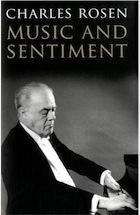Music and Sentiment by Charles Rosen
Simon Callow will never listen to Brahms in quite the same way again
 Musician-writer Charles Rosen. Photograph: Graham Turner for the Guardian
Musician-writer Charles Rosen. Photograph: Graham Turner for the GuardianMusic continues to nag away at us. How does it do what it does? The strange potency, not just of cheap music, as Noël Coward so memorably remarked, but of all music, thrills and baffles us. There has never been more of it available, of a range unimaginable to music-goers of even 50 years ago, stretching from across the globe and back through history, introducing and reintroducing us to modes new and forgotten, strange rhythms, mysterious harmonies, arcane structures.
Ethnologists and anthropologists have always been fascinated by its cultural significance, but more recently, scientists too have attempted to comprehend the phenomenon: a decade or so ago, Robert Jourdain's Music, the Brain, and Ecstasy offered a provocative account of the physical processes, followed by the neurologist Oliver Sacks's Musicophilia and the cognitive psychologist Daniel Levitin's This Is Your Brain On Music. Practising musicians have been less forward, though Daniel Barenboim in his Reith lectures offered some musings on the subject which tried to talk about music in general philosophical terms and were emotionally uplifting without being musically illuminating.
There has been a welcome increase in the last few years in the number of interpreters and performers willing and able to write in analytical detail about their craft: in this country, the conductor and lutenist Anthony Rooley's Performance is a thrilling account of what music meant for performers and audiences in the Renaissance; the cellist Steven Isserlis and the pianist Stephen Hough have written brilliantly clearly about the way the music they play works; and another pianist, Susan Tomes, has contributed two remarkably probing books, Beyond the Notes and Out of Silence, to the literature.
The granddaddy of all these writer-musicians is the American pianist and scholar Charles Rosen, a performer of the utmost distinction whose writing exactly mirrors his playing: subtle, precise, penetrating and, though by no means lacking in fun, intended to challenge. His magisterialThe Classical Style has never been out of print; Sonata Forms andSchoenberg are as clear as anything that has been written on either subject; and Piano Notes unforgettably describes the physical and emotional experience of being a pianist.
In Music and Sentiment he turns to the big subject of how music performs its miracles, but, characteristically, he focuses on a seemingly limited aspect of it: "how the change in representing sentiment in music was developed, and what it could mean for the conception of music". The apparent dryness of this theme is contradicted on every page.
Working his way from the end of the 18th century to the 20th, Rosen shows how composers evolved the ways in which they communicated and how audiences learned to understand what they were doing. He declines to define the emotions the composers were expressing (easily identifiable anyway, he reckons): what interests him is the discourse, and how it was conducted. Eighteenth-century composers, for example, played with the relationship between dissonance and consonance, dissonance creating a tension which is then released, to gratifying effect, by a consonance. Audiences knew and expected this pattern; they weren't taught it; they simply imbibed it with the rest of the culture.
Rosen analyses this, and other compositional procedures, without concession to the general reader. The core of his argument concerns the relationships of keys to each other, the establishment of a tonal centre, the sequence of tonic, dominant, subdominant. As a general reader myself – an attentive and committed listener, but one with no musical training – it's no good pretending that the book is anything other than challenging, but, with rare exceptions, his analysis is so clear and cogent, so evidently deals with the very life-blood of the pieces in question, that if you're prepared to stay the course, he reveals with surgical precision the actual processes that so affect you. There are plentiful music examples; it would have been helpful if a CD had come with the book, but all the music he refers to is easily available.
What is astonishing, given the rigour of the analysis and the apparent technicality of the approach, is how moving the book is. His account of the first movement of Mozart's String Quartet in G major, K387, revealing what he characteristically calls its "variety of affective nuances", closely analyses every dynamic contrast, the alternation between diatonic and chromatic harmony, "the hidden and symmetrical contrast of sentiments". It gives a profound insight into a work that has always stirred me without my ever comprehending why. In one of his lightly waspish throwaways, he dismisses the argument of a certain scholar: "this may be musicology, but is not news."
Music and Sentiment is both musicology and news. It changes the way one understands not just music but art in general. He traces the growth of romantic sensibility in general as a craving for continuity of emotional experience, and charts the embodiment of this in music: rather than building to a climax, the initial material becomes filled with a sense of mounting excitement. In one of his best phrases, he describes this as an aesthetic of continuously rising sentiment.
In a revelatory passage, he shows how Brahms, barely acknowledged as an innovator, achieves a great deal of his emotional power from a radical use of colour. Rosen demonstrates this with a brilliantly chosen example from one of the cello sonatas; it is no exaggeration to say that I shall never listen to Brahms in the same way again. He notes how what he calls "the chromatic saturation of the musical language" after Schubert makes it hard ever again to express simple innocence or happiness, and trenchantly notes that his admired Schoenberg, far from being dry and cold as a composer, writes music which is "uncomfortable because of exaggerated emotional hysteria".
He ends by cheerfully observing that perhaps "a good deal of the foregoing account is less relevant to the experience of the average concertgoer than we might like to believe", in the light of the poet Giacomo Leopardi's observation that most people prefer a bad melody sung wonderfully to a good one sung badly. But should you want to open yourself to what is there in the greatest music, this very concise book is not just a companion, it is an education.
Simon Callow's My Life in Pieces: An Alternative Autobiography is published by Nick Hern.
- 文章地址: http://wen.org.cn/modules/article/view.article.php/c3/2104
- 引用通告: http://wen.org.cn/modules/article/trackback.php/2104









